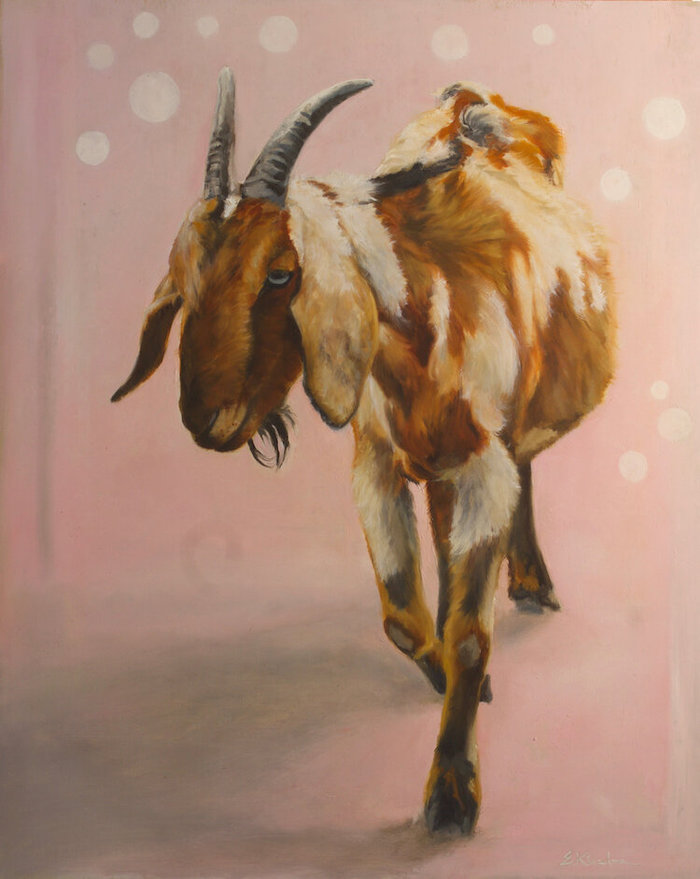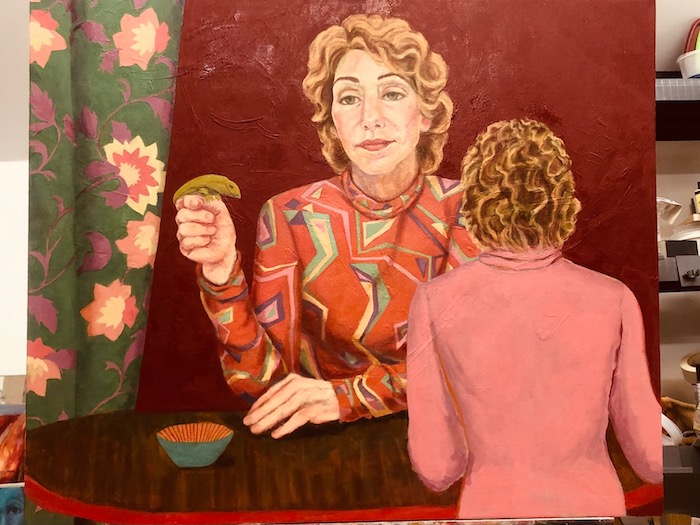For too long I have been noticing artists posts things like this on social media.
Fresh off the easel! What do you think?
I’m experimenting with <this or that>. Let me know what you think.
Thinking of doing <this or that>. What do you think?
What do I think? Do you really want to know what I think?
In this episode of The Art Biz podcast, and in this post, I want to talk about feedback. When you ask people What do you think? you’re asking for feedback. Even if you aren’t asking intentionally.

We are often too quick to ask for feedback, and we ask for it in ways that can be damaging.
We’re equally guilty of giving feedback when it’s not requested (or wanted).
I’ve been guilty of both—especially the latter—and I’ve learned a lot about giving and receiving feedback. I owe much of what I know about feedback to Cynthia Morris, an artist, coach, and host of the Stumbling Toward Genius podcast. I also, as you’ll hear, am indebted to Tara Mohr, author of Playing Big.
What I share here is what I’ve learned from those women, from others, and from paying attention to what’s going on with my students and clients.
This post is a transcript of the podcast.
Feedback is serious.
Feedback can be powerful stuff. You should only ask for it if you (1) really want to hear meaningful assessments, (2) frame it properly, (3) ask the right people, and (4) are prepared to hear and respond to the answers.
At many points during the creative process, your project is in a delicate state. You might have a direction and be excited about it or, alternatively, not know what you’re doing. You might have just completed it and are feeling enormous satisfaction and pride.
Proceed with caution when you’re at these fragile moments. Asking for feedback too early doesn’t give you time to nurture your baby. The wrong words—or even the absence of words or those all-important likes—could put a quick halt to any enthusiasm you had and before you know it, your bubble has burst. Ouch!
Anyone who has sat through a crit in art school knows what this feels like. Formal critique can build your backbone and prepare you for opening your art to others. They can also sting. But in a formal critique, you know the rules going in. You know what to expect.

The problem with the way feedback is doled out so randomly online these days is that there are no rules, and few are prepared to face any kind of criticism.
How not to ask for feedback and who not to ask.
This episode was prompted by an Instagram post I saw not too long ago that was similar to many that I mentioned at the top of the show. It said something like this:
Here’s my new X. Let me know what you think.
I see all over social media: What do you think?
Let’s pause and consider those words.
What. Do. You. Think?
Boy, those words could really open a can of worms! And, yet, they’re dropped so casually into posts, emails, and more.
What do you think?
I hope this post makes you think. Think twice about asking people what they think.
I am not sure that asking on a post What do you think? is being done because the artists think they care what people think, because they really do care what people think, or because they can’t think of anything else to type into the post. I suspect it’s the last thing on that list—that they can’t think of anything else to type into the post.
Regardless … Please stop doing this.
When you ask what people think on social media, you’re asking EVERYONE what they think, and, frankly, you shouldn’t care what they all think.
I’ll say that again. You shouldn’t care what everyone thinks! The result could be feedback that you neither want nor need. But there is another reason not to do this.

You, above all, need to believe.
Asking What do you think? in a social media post sounds like you’re fishing for affirmation, which you absolutely don’t need (no way, no how) from any of your followers. This makes you look insecure and indecisive.
It’s like those awful messages you get to “vote for me” in this or that competition. Thank the art goddesses that this isn’t as rampant at it once was because it’s super icky. (Competitions are a whole other topic I’d like to explore in a future episode.)
You need time to figure out what you think about it before you ask others what they think about it. You need a safe space for your creative output to incubate without criticism or praise from voices that, in the end, don’t matter.
Asking what everyone thinks isn’t helpful. Especially if it’s new work that you’re still trying to understand for yourself.
My wish for you is that you keep working. Keep nurturing your ideas. Build up belief in yourself to the point that you don’t give a rat’s patooty what other people think. After all, YOU believe in the work. That’s what’s important.
Then you’ll find more appropriate and well thought-out words to accompany your posts. More substantial than What do you think?
I’m going to talk about how to properly ask for feedback, how to give it, and how to respond to feedback. But first, an invitation.
I’d like to invite you to become part of our community of ambitious, committed artists at the Art Biz Connection. Being an artist is, for the most part, a solo endeavor. For most of your life, you’re working alone in the studio. But you don’t have to build your business alone.
In the Art Biz Connection, our members share their challenges, solutions, and ideas. We can offer plenty of feedback when the time is right for you.
If you are tired of trying to figure it all out yourself, I hope you’ll take a look. Our artists are all over the world, and we value diverse experiences. Join us!
Feedback is necessary.
At some point, feedback is necessary when you want to improve, but you have to set up the parameters. You have to know what you’re getting into. As I said earlier, feedback is serious business. You should only ask for it if you (1) really want to hear meaningful assessments, (2) frame it properly, (3) ask the right people, and (4) are prepared to hear the answers.

In her book, Playing Big, Tara Mohr has a wonderful chapter on unhooking from praise and criticism.
Feedback is not meant to give you self-esteem boosts or wounds. That’s not its place. It is meant to give you tactical information about how to reach the people you want to reach. Feedback is emotionally neutral information that tells you what resonates for your desired audience, what engages the people you want to engage, what influences the people you want to influence.
She says it’s “just useful data, nothing more.” I understand her thesis to be that we can unhook from praise when we learn to value the work we do—that, as she says, “both service and self-expression are more important than praise.” Again, you have to believe in the work you do. It has to be valued more for itself, not for how many likes you can receive on Instagram.
Ask the right people.
Yes, feedback is useful at the right time, but you want feedback from people who count. Feedback from potentially everyone on social media is a sideshow. Even if it’s praise.
The desire for praise is every bit as toxic as the desire to avoid criticism.
Tara Mohr, again from her book Playing Big, thinks that you don’t need feedback from family, friends, experts, or mentors. She says, “The most important people to gather feedback from are the intended audiences and decision makers you need to influence or reach.”
I have different viewpoint for artists. I believe that you will significantly benefit from being part of a structured critique group of other artists you trust. The right artists can offer inquiry that helps your work develop. And, for artists, the critique process helps prepare you to face the broader public so you can find your intended audiences.
Feedback from other artists with well-trained eyes and experience is useful. Join a critique group! Listen to episode 61 of The Art Biz with Patricia Miranda about the value of critique groups.
Feedback from your potential audience can also be very useful, especially if you have a niche audience or are looking for commissions.
As an aside here, I wouldn’t be able to talk so passionately about this if I didn’t have a lot of personal experience with the topic. I thrive on praise and I’m heartbroken from criticism.

How to ask for better feedback.
What do you think? is a wide open question. It puts people on the spot to, again, give you some kind of praise. It also requires them to do all of the heavy lifting. In order to give an informed opinion, they need to look, analyze, and consider. Setting aside the fact that you’re probably not really asking them to do this, that’s a big ask.
Instead of asking such a huge question, be specific and give parameters to contain the feedback. Here are some examples of how you can ask with specificity.
- I have a new website and I’ve gone a different direction with my About page. I think it’s quirky and clever, but I’d love to know if you think it’s as quirky and clever as I do or if you are turned off by it. You want this kind of feedback from potential buyers or students.
- I am finishing up this piece. I’m not sure about the red chair in the foreground. Does it work for you? Do I need to add red somewhere else? You’re looking for someone with trained eyes to chime in on this topic.
- Can you tell me what you like most about my art? I’m sure there are weaknesses, but I would love to hear what you think my strengths are. Great question for a crit group!
I would be remiss if I didn’t also discuss giving feedback and receiving unrequested feedback.
How to give better feedback.
I am amazed by all of the people who freely give unrequested feedback online to people who don’t know them. Online seems safe because it’s more removed than saying it face-to-face or even on the phone.
Before doling out feedback willy-nilly, ask yourself if it’s your place to do so.
Do they really want your opinion?

If someone is unequivocally asking for feedback, honor the boundaries that the person has provided. Consider the OREO® approach: two disks of praise protecting the fluffy center that has room for improvement (aka “the shit sandwich”).
I really like the way you did X and wish I had thought of that. Maybe Y would make it stronger. But you should trust that you’re definitely headed in the right direction.
If the person requesting feedback hasn’t listened to this episode and asks a vague question about getting your feedback, ask for clarification.
Can you be more specific? What kind of feedback are you looking for?
If you haven’t been asked and are tempted to give feedback, maybe send a private message before launching into your comments. Something along the lines of: Are you looking for feedback on that?
Sometimes we only want positive support, which has its place in the creative process.
I have a deal with people who support me. In unveiling my most recent project to them, I simply say, “Wanted you to be aware of my new X. At this point, I am not looking for critical feedback. I want you celebrate with me the fact that I’ve completed it.”
This is a way of safely sharing what I make without asking for gratuitous praise or opening myself up to criticism at a vulnerable point. You’re welcome to steal it.
How to respond to feedback.
If you have asked for feedback, you must, after reading this, have been prepared to receive it. Graciously.
Always accept the feedback with gratitude.
Thank you. You’ve given me some things to think about.
Feel free to ask clarifying questions.
Thank you. Tell me more.
Thank you. Can you clarify <this or that> so I can better understand?

Then there is the feedback you receive that you never asked for in the first place. Here are 3 ways to respond to feedback you didn’t request.
1. Thank you for sharing your opinion.
There’s something about this response that tells the other person that their opinion is not wanted. I’m only brave enough to pull this one out of my bag of tricks in the most extreme circumstances, which usually means that the person was rude or cruel.
2. That’s interesting. Why do you say that?
This is a great line if you want to engage the other person in dialogue. It asks the person to be responsible for their comments, not in a negative way, but as they should be.
You might learn something in the process. For example, you might find out that what you understood wasn’t at all what was intended.
3. Ignore and delete.
Sometimes the only thing we can do is delete an email or move on to the next comment.
This is great for the online world, but it doesn’t help when face-to face. Oh, if it were that easy to delete people! In the case of a real life encounter, revert to #2 above.
A bit of advice. When deleting a particularly out-of-place comment, take a moment to send the other creator love and light, and then imagine them receiving your generosity. It will put you in higher energy vibration.
Finally.
I’ll wrap things up with this appeal: Stop asking everyone what they think on social media. If you really want feedback, ask the right people in the right environment and with specificity.
What kind of feedback are you looking for. Take time to get to know your work and craft your ask before looking for praise or criticism. Finally, be careful about how you give feedback. Make sure it’s your place to do so.
Remember … If you are looking for a safe place to find feedback, you might just find it inside of the Art Biz Connection, our community of committed and ambitious artists. Membership is open. Read the details and join us now!
A version of this post was originally published on August 20, 2015. It has been updated and significantly expanded, with the addition of the podcast. Original comments were left intact.




26 thoughts on “The Art Biz ep. 115: How to Get Better Feedback When You Want to Improve”
I love how you are telling us to own our asks!
Artists seem to be always asking for feeback, evaluation, confirmation, etc. and then are shocked when someone actually critiques their work, or OMG, doesn’t like it. So I think you are dead on about throwing out the caution sign before putting it out there.
Pesonally I love negative feedback. Sure it hurts my feelings sometimes, but when I let go of that, I ALWAYS learn something and my artwork grows from that critique.
Postitive comments are great for the ego, but for the most part don’t push me to do anything different, and we all need that little kick in the pants to grow.
Great attitude, Josephine. I’ll bet your feelings wouldn’t be hurt as much if people were more careful with their words.
You’re right on! I’m a member of a local art group. Many of the members are hobbyists and enjoy just creating. Some are uncomfortable with feedback even when it’s asked for. So we call it gentle suggestions to make them more able to accept the comments given. We take the Oreo approach, too, and it works. Like Josephine, I like specific critiques, having been used to them in art school and as a graphic designer. Thanks for an insightful article!
Thank you for sharing your experience, Jean. Feedback for hobbyists should, indeed, be quite different. Sounds like you are all sensitive to their position.
WonderFULL post Alyson.
This topic is huge…and bears constant tuning.
O the humanity❗
????
🙂
Again, so brilliant Alyson, and compelled me to connect a colleague with you….All best!
Once I used to hangout in a large popular forum and there it was this section moderator that always commented for feedbacks, I got tired of her because her comments were always negative, and in the top of that she assumed used techniques or materials when it wasn’t the case.
I have a thick skin for criticism, it makes me angry when people think they are better than others, so I decided to leave and report her to the admins.
About asking feedback on FB, good point about how to ask, I had had only 2 replies about my website redesign, I wish I had more. I asked specific questions, and pointed some flaws I’m still working on them.
Sikiu, I’m glad you protected yourself and left.
Maybe ask the question on FB again at a different time of day.
Thanks for the post Alyson. I’m with Josephine too, love critical feedback, always helps my work. I’ve also learned that when I ask for feedback from trusted sources I don’t explain or discuss the work. I let them be with the piece and comment. Only then do I begin asking for specific feedback. This gives me the best chance of getting the widest, most authentic response, and responses to what I’m unsure of as well. I rarely ask for feedback on social media. Just don’t see the point. People can come see the show and give feedback then. ☺️
Excellent approach, Kristen.
Sometimes feedback on social media could be as simple as “What should I title this?” Which seems pretty innocuous.
Wonderful post, Alyson. As a teacher, I had been using the Oreo approach without knowing it. The image is perfect.
Great instincts, Donna. Lucky students.
Hi Alyson.
Very interesting topic. I’m not as thick skinned as some others who have responded, so here is another viewpoint. Relationship with the person giving me feedback is really important. Yes feedback is about something that I’ve made and a reflection of myself, and it’s a reflection of the other person. I need to understand that other person to really take in their feedback and work out what part of their offering is useful for me, and how I can make use of it. And yes, the relationship skills we both bring to the space of feedback are crucial especially if the feedback is difficult. So I am careful who I ask. On Facebook I’m more likely to ask about how a painting engages with my viewers imagination and feelings. That’s what I want to encourage in an online conversation. Thanks for the topic.
Warmly Lynn
How would one go about locating a company to provide mural restoration in Chicago?
I don’t ask for feedback…
Not really a fan of comments on my blogs so I don’t really encourage them…
Generally speaking if I want to know your opinion of my work, I will give it to you…(LOL)
Why open myself up to pain? (There will be pain, there is always pain…that one person who is having a bad day or is jealous or just feels like playing devil’s advocate…)
On the other hand, when our dear ArtBizCoach offered a free word about our art many years ago, me, a newcomer, asked the question…
“handsome” she said…
I was in…
Years & years later I was bold enough to send some new work by email…
It was art in medicine…Charts…really new ideas I was having about medicine…
‘Follow that path’ was the gist of the answer I got…
I did, & wrote 8 books about medicine from the perspective of an artist…(they are free on my site btw)
I asked the right person…
& I am forever grateful…
Thanks Alyson!
I like Sari’s attitude and I just realized I haven’t asked opinions about my work in many years and don’t even miss it. I tend to ask more about how user friendly is my website, help with my wording and things like that since English is my second language and web design a necessary skill I learned while ago but still I’m not in the level were I feel comfortable.
To know if I’m going in the right direction with my art I first look at the quality of the art on museums comparing to mine and that tells me more than what anybody could say.
my feedback comes from my muse, but she can be brutal.
Feedback is a necessity. If you don’t have it, you are working in a vacuum. It’s important to know viewers’ reactions. Of course, we all want them to be positive. But negative feedback can be encouraging too because it means that the critic is engaged with your work enough to think about it, analyze it, and that he or she cares about it enough to make comments. My standard reply to negative comments is, “Thank you. You’ve given me something to think about.” And then I do think about it and either adapt or discard it.
Perfect! I only wish issues were that simple in marketing, and maybe they are, but I haven’t grasped that yet!
Great article! I love the idea of the OreoFeedback. Most of the time people are Not ready or not taught how to give feedback.So when asked to give feedbackYou understand it as simply Giving negative criticism.Not because they don’t see anything positive on your work, But because,As you said,They don’t have any parameters to start with.
ThisArticle also made me Reflect on How I am a person who tends to give critical feedback without askingWhat kind of feedback the person is asking for. I tend to be a fixer. This is a great exercise To be more empatheticWhen giving feedback.
Thank you!
Usually when asked for comments my response would be about initial emotion. Pleasing color, composition, all the technical stuff that contributed to the piece, would be the first visual discussion. Often an artist will stop there. Sometimes another memory comes up.
“I was looking for my cat under the porch and the patterns on the stairs made me stop.” That is the response I hope for. The spark that stimulates the artist to create should always be encouraged.
Thank you Alyson, feedback is always a thorny issue, but very helpful when wanted and done properly. The point about feedback being requested is particularly relevant. Last year I was demonstrating outside an exhibition I was taking part in – it was a hot day and a beautiful location, all very lovely. Mostly it went well but I spoke to one chap (an art teacher) who felt it necessary to tell me how I should “correct my grip so I could draw more freely”. Completely inappropriate and uninvited. Fortunately, I maintained my cool and felt I handled the situation politely.
Especially when giving feedback to students, I first always find something to praise about the painting. And depending on their skill level, I can give appropriate suggestions or hints on areas that could use additional work. I usually preface it with “Others may have different opinions but this is mine and you as the creator are the ultimate decision maker.”
Hi, It is a joy (spelled JOY) to receive your newsletters and advice articles regarding the immensely subjective and impossibly nuanced business (with a capital B) of Art.
Grateful (:
Thank you, Ricky! I appreciate hearing from you.